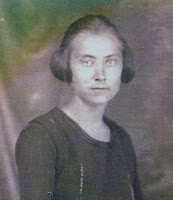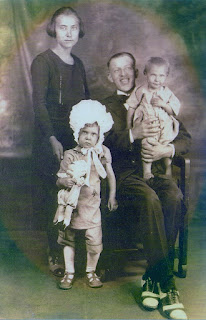Selma (Kangas) Tully (1894 – 1949)
|
Selma (Kangas) Tully, about 24
years old. Anaheim, California, November 24, 1919. |
In this day and age, it is common to see hundreds, sometimes thousands, of photographs marking the great and small events of a person’s life. In the case of Selma Tully, however, we have a single photograph that leaves us to wonder about her life before and after it was taken.
The passenger list for the R.M.S. Mauretania notes that Selma was a servant, hinting that even as a teenager she had to work in exchange for room and board. It describes her as not quite 5’2″, with fair skin, and brown hair and eyes. When my father-in-law, Welner “Bing” Tully, described her, it was not in a physical way but rather a personal, if not wistful recollection of his mother as a sweet and gentle woman who loved him and his sister tenderly.
The Mauretania arrived in New York Harbor on February 26, 1910. Nearly a week later, the 16-year-old stepped off a Union Pacific train in snowy, desolate, Kemmerer, Wyoming, minutes from the mining town that would be her home for the next six years, unsure about what awaited her but ready to dive into her new life anyway. She helped her brother and sister-in-law with the children and learned to speak, read, and write English.
As much as she loved her brother and his family, Selma knew she could not stay with them forever. She needed to make a life of her own, and Portland, bustling and full of opportunity, seemed to be the place to do it. If the Oregon Kangases were indeed relatives, it would be plausible to imagine that she felt comfortable in deciding that now was the time. She found a job as a hotel chambermaid and kissed her family goodbye, promising to write often. As far as we know, they did correspond after that, but the great distance kept them from seeing each other again.
|
The Tully family: clockwise: Selma,
Arthur, Welner “Bing,” and Vivian.
Anaheim, California. November 24, 1919.
|
The family, decked out in their best clothes, posed for a portrait on the day after Thanksgiving of that year. Here we see Selma in a plain dark dress and sweater, resting her hand on three-year-old Vivian, who clutches a doll and looks slightly bored. Arthur, dressed in a three piece suit, sits jovially in a wooden armchair, balancing his bouncy, wide-eyed 10-month old son Bing on his lap.
The struggle to survive hit the Tully family as hard as it did many others. Something happened to Arthur, and the 1930 United States Census shows Selma and her two children living without him on Bonsallo Avenue in Los Angeles.
Times were desperate. Selma did the best she could to support herself and the children; Bing recalled helping her iron flour sacks to make money. Sadly, she was fighting a losing battle, and there was no one there to help her.
It is hard to imagine the unbearable pain and helplessness Selma endured during that period of her life, especially with her brother Matti living thousands of miles away. She must have been terrified by the reality that her money had run out and she had no way to care for her children. As if that were not enough, the thought of their having to suffer without her parents, as she had done all those year ago in Finland, was more than she could take.
Thankfully, Vivian and Bing had what we today would call a safety net. In 1934, their maternal aunt and uncle, Amelia (Tully) and Thomas Binning, who already had a combined total of eight children, took them in and raised Vivian and Bing as their own.
What happened to Selma after that is hard to say. There is no documentation on her life until February 15, 1949, when the California Office of Vital Records notes her death of pulmonary tuberculosis in Ventura on February 15, 1949. She was 54 years old.
 |
| Selma (Kangas) Tully is buried at Ivy Lawn Memorial Park, Ventura, California. May she rest in peace. |
I think she would have been happy to know that Vivian and Bing made successful lives for themselves, married and had children and grandchildren, and never forgot their humble yet loving origins. Bing treasured the family photograph all his life and hung it in a prominent place in his living room. It was a tangible reminder of a mother who had made the ultimate sacrifice for her children.
In 1971, he received a letter from his cousin John Kangas, one of Matti’s sons. In it, John wrote of having traveled to Finland, “a long postponed trip that every good Finn should make, at least once.”
Bing’s own chance to go to his mother’s homeland came in 1991, when he made a personal pilgrimage to Helsinki and took a bus from there to Yliharma, in what was then called Vaasa province. Unable to speak Finnish, he had no luck in finding his mother’s home, but it gave him some comfort to think he was walking down the same streets she had so very long ago.
************
Copyright © 2017 Linda Huesca Tully


Oh, Linda, I teared up reading about Selma's life and what she endured. I imagine that having a daughter gave her some joy–I do hope!
I think it did, Marian. Vivian and Bing loved her dearly. I would like to think they have all been reunited in Heaven and are smiling down on their beautiful family. Thank you so much for your comments.
What an incredibly sad story. Thank goodness, though, that Vivian and Bing had family to take them in.